Heckler & koch usp
I must say that the idea of turning a pistol into the main “weapon of the last throw” is not new. Even during the First World War, the Germans armed assault teams with powerful long-barreled pistols such as “Parabellum artillery” or “Parabellum carbines”. The well-known military theorist A.Neznamov wrote in the book "Infantry" (1923): "In the future ... for a" strike "a weapon with a bayonet may be more advantageous to replace with a gun with a dagger (a pistol with 20 cartridges in a store and a range to 200 m) ". However, in the military, and in the police field, this task was allowed at that time by submachine guns. In 80-ies, the idea of a powerful "assault" pistol was revived again, but this time it was tied to the needs of special forces. Bulky models of the type GA-9, Р-95, etc. came to the market. Their appearance, accompanied by noisy advertising, was not accidental.
According to a number of American experts, the 9-mm pistol М9 ("Beretta" 92, SB-F), adopted by the 1985 for replacing the 11,43-mm М1911А1 "Colt", does not fully meet the requirements of close combat in terms of accuracy and effective range firing. With a silencer, the effectiveness of the gun is markedly reduced. SOCOM wanted to get a compact, for carrying in a holster melee weapons (up to 25-30 m) battle. He was supported by the US Army Command. Since among the "consumers" of weapons were the teams of combat swimmers (SEALS), the main requirements of the program were presented in October 1990 by the center of special methods of warfare of the Navy. It was supposed to get the first 30 prototypes by March, 1992, to test full-scale samples in January, 1993, and in December, 1993, to get a batch of 9000 units. In the military periodicals, a new project was immediately dubbed "SuperGun".
As the main uses were considered: the battle on the street and inside the buildings, the hidden penetration of the object with the removal of sentries, the release of hostages or vice versa - the shares of abduction of military or political figures.
The "super gun" was considered as a complex that included not only a "family" of cartridges and a self-loading pistol, but also a device for silent and flameless shooting, plus a "aiming block". The modular scheme allowed for the assembly of two main options: "assault" (pistol + aiming block) and "scout" (stalking) with the addition of a silencer. The weight of the latter was limited to 2,5 kg, length - 400 mm.
The main requirements for the gun were as follows: large caliber, magazine capacity not less than 10 cartridges, reloading speed, length no more than 250 mm, height no more than 150, width -35 mm, weight without cartridges - up to 1,3 kg, convenience for shooting with one and with two hands, high reliability in all conditions. A series of 10 bullets should fit on a circle with a diameter of 25 inch (2,5 mm) on 63,5 m. Accuracy had to ensure the balance of the weapon, the muzzle - a compensator and ease of retention. The latter, in the opinion of many, suggested a large slope and almost sporty design of the handle, bending of the trigger guard for imposing the finger of the second hand. Bilateral controls were considered necessary (fuse, shutter lag lever, magazine latch) available to control the brush holding the weapon. The trigger mechanism was supposed to allow adjustment of the triggering force: 3,6-6,4 kg with a self-coil and 1,3-2,27 kg with a pre-cocked trigger. Putting on the fuse as when the trigger is lowered, and when the trigger is cocked. The lever of safe descent of the trigger was desirable in case the shot was not needed. Aim devices would include replaceable front sight and adjustable rear sight height and lateral displacement. For shooting at dusk, the front sight and the rear sight would have luminous points - a device that has become common in personal weapons.
For the "supergan" chose the good old 11,43-mm cartridge ".45 ASR." The reason - the requirement of a specific defeat of a living target in a minimum time at maximum distance. The stopping effect of the NATO 9xXNNUMX NATO bullet caused a number of discontent among the military. With a conventional shell pool, a large caliber, of course, gives more guarantees of damage from a single hit. Even with a bulletproof vest, the target will disable the dynamic impact of 19-mm bullets. The strong and sharp return of such cartridges was not considered essential for physically strong guys from the “special forces”. Three main types of cartridges were called:
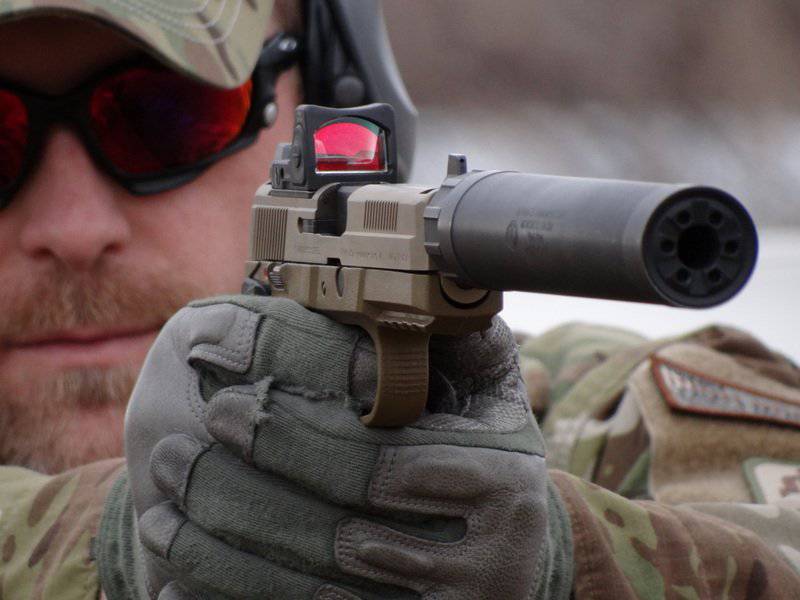
- with an “improved” type shell bullet - in terms of improving ballistics and enhancing punching action, with an increased slaughter bullet - for antiterrorist operations, training with easily collapsing bullet and with enough power only for the operation of automation. In addition, it was considered probable to create a bullet of increased penetrability, which is guaranteed to hit a target protected by 25 (in the NATO classification) class on the 3.
The aiming unit was conceived as a combination of two illuminators - a conventional and a laser. The usual, creating a stream of light narrow, but a bright beam, served to search and identify the target at night or indoors. The laser worked in two bands — visible and infrared (for working with night glasses of the AN / PVS-7 A / B type) —and could be used for fast laying both at night and during the day. His "spot" should have been clearly projected within the silhouette of a person at a distance of 25 m. The unit could be turned on with the index finger of a hand holding a weapon.
By the CBE presented the requirements of fast (up to 15) fastening and removal, m balance. In any case, the installation of PBS should not shift the STP by more than 50 mm by 25 m. If the gun will have automatic with a moving barrel, the silencer should not disrupt its operation.
In general, the requirements for "offensive personal weapons" did not suggest anything fundamentally new and relied on the parameters already achieved. This made it possible to count on the implementation of the program for three years.
At the start of 1993, SOCOM actually presented thirty “demo” samples. In this case, the clear leaders were the two largest arms firms "Colt Industries" and "Heckler und Koch." During the year, their samples were carefully studied, trying to determine ways of further development.
The sample "Colt Industries" was generally designed in the style of the M1911 А1 "Colt" pistols of the Mk-IV - 80 and 90 series with modernized retention bodies and a number of improvements in the trigger mechanism and the operation of the automation. Controls are concentrated at the handle. For use by combat swimmers (on land, of course) all the elements of the mechanism are made "not water-fearing." The silencer and the aiming unit also looked quite traditional.
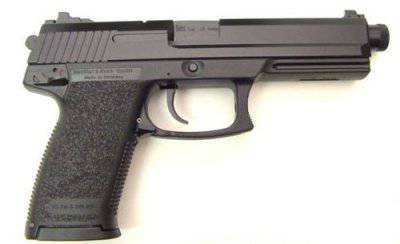 Pistol "Heckler und Koch" was based on a new model USP (universal self-loading pistol). Initially, the USP was designed in nine and ten millimeter versions, but for the Offensive Handgun program it was made for the “.45 ACP” cartridge.
Pistol "Heckler und Koch" was based on a new model USP (universal self-loading pistol). Initially, the USP was designed in nine and ten millimeter versions, but for the Offensive Handgun program it was made for the “.45 ACP” cartridge.An offensive personal weapon version of the USP with the Reda Naytos silencer was presented in October at 1993 at an exhibition organized by the American Army Association (AUSA). It may be noted that the overall weight of the system, stunned to 2,2 kg, is a concise and user-friendly design, literally inscribed in the contours of the frame aiming block. Its switch is located within the trigger guard. Note that the Colt and Heckler und Koch "demo" samples had a constant sight, more typical of pistols. The angle of the grip of both was less than expected. Another significant feature of the samples is the ability to put them on the market for other purposes if the Offensive Handgun program fails.
The choice of the SOCOM sample was expected in 1995. But even then, the Offensive Handgun program was criticized. In the editorial article of the magazine "Modern Gun" in June 1994, the idea of a large-caliber "offensive" pistol is simply called "stupid." It is said with a fuse, but the idea is really controversial.
In fact, is it necessary to hold on to the 45 caliber and endure the tilting effect of recoil (recoil force ".45 ACP" - 0,54 kg) and increase the weight of the gun to the level of a submachine gun? The biggest stopping action is worth nothing if the bullet passes by. Maybe it is better to put two or three bullets into the target with a somewhat lower rate of slaughter, but with better accuracy? With a total weapon length of 250 mm, the barrel length should not exceed 152 mm or 13,1 caliber, which threatens to reduce ballistic data. Reducing the caliber would increase the relative length of the barrel and increase accuracy. A small submachine gun with a variable firing mode remains a serious competitor to the self-loading "offensive personal weapon". This type of weapon is more versatile and, moreover, has already occupied its niche in the range of melee weapons.
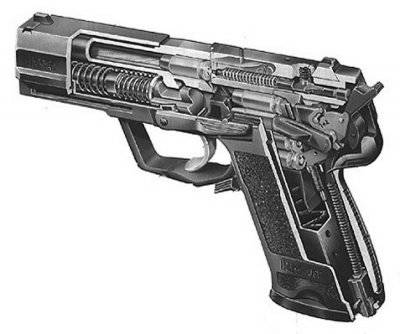 However, in the fall of 1995, SOCOM still chose the 11,43-mm USP to implement the "third phase of the contract." The third phase involves the release of "Heckler und Koch" 1950 pistols and 10 140 stores to them with the start of deliveries to 1 in May 1996. The pistol received the official designation Mk 23 "Mod About US SOCOM Pistol". A total of about 7 500 pistols, 52 500 stores and 1950 silencers can be ordered.
However, in the fall of 1995, SOCOM still chose the 11,43-mm USP to implement the "third phase of the contract." The third phase involves the release of "Heckler und Koch" 1950 pistols and 10 140 stores to them with the start of deliveries to 1 in May 1996. The pistol received the official designation Mk 23 "Mod About US SOCOM Pistol". A total of about 7 500 pistols, 52 500 stores and 1950 silencers can be ordered.Consider the USP device in more detail. The barrel of the gun is made by cold forging on the mandrel. In combination with polygonal cutting, this gives it high accuracy and durability. Cutting the chamber allows you to use the same type of cartridges from different manufacturers and with different types of bullets. Installation of the muffler allows elongated barrel.
Experts had expected Heckler und Koch to use a fixed-barrel scheme like its P-7. However, the USP automatics works according to the barrel recoil scheme with a short stroke and a barrel distortion. Unlike the classical schemes, for example, Browning High Power, here the barrel reduction is made not with a rigid frame pin, but with a hook installed at the rear end of the recoil spring core placed under the barrel with a buffer spring. The presence of the buffer is designed to make the automation work more smoothly.
The frame of the gun is made like pistols "Glock" and "Sigma" of molded plastic. The four slide-casing guides are reinforced with steel strips to reduce wear. Reinforced plastic, a magazine latch, a trigger, a trigger box, a lid and a store feeder are also made of reinforced plastic. On the frame of the gun itself there are guides for fastening the flashlight or LCC. The shutter-casing is manufactured as a single part, milling from chrome-molybdenum steel. Its surfaces are subjected to nitro gas treatment and crowed. To all this, a special “NOT” (“aggressive environment”) treatment has been added, allowing the gun to withstand immersion in seawater.
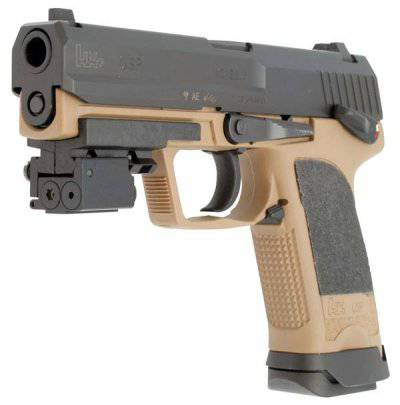 The main feature of the USP is its trigger mechanism. At first glance, this is a common hammer-type mechanism with a half-hidden trigger and a two-position flag placed on the frame. However, by replacing the special plate-clamp, it is possible to switch it to five different work options. The first mechanism of double action: at the top position of the flag, shooting with preliminary cocking of the trigger is possible, at the bottom - only with self-cocking, and lowering the flag safely pulls the trigger. The second option: when the flag is moved to the top position, the “fuse”, to the bottom one, the “double action”, this is just the most typical of service weapons. In the third variant, it is possible to fire only with pre-cocking, there is no fuse, and the flag is used as a lever for safe descent of the trigger. The fourth option is somewhat similar to the third, but shooting is possible only by self-cocking. The fifth and final version sets the "self-input" and "fuse" modes. I would like to add that in each of the modes the box is located at your discretion - on the right or on the left. The requirements of the American program most correspond to the first and second option. Selection can be done only by a qualified master. The triggering force with pre-cocking is 2,5 kg, self-arming - 5 kg, that is usual for a service pistol. There is also an automatic safety lock-clamp, which fixes the drummer until the moment when the trigger is fully pressed. There is no lock fuse, so a shot after its removal is not excluded, the lack is small but still unpleasant.
The main feature of the USP is its trigger mechanism. At first glance, this is a common hammer-type mechanism with a half-hidden trigger and a two-position flag placed on the frame. However, by replacing the special plate-clamp, it is possible to switch it to five different work options. The first mechanism of double action: at the top position of the flag, shooting with preliminary cocking of the trigger is possible, at the bottom - only with self-cocking, and lowering the flag safely pulls the trigger. The second option: when the flag is moved to the top position, the “fuse”, to the bottom one, the “double action”, this is just the most typical of service weapons. In the third variant, it is possible to fire only with pre-cocking, there is no fuse, and the flag is used as a lever for safe descent of the trigger. The fourth option is somewhat similar to the third, but shooting is possible only by self-cocking. The fifth and final version sets the "self-input" and "fuse" modes. I would like to add that in each of the modes the box is located at your discretion - on the right or on the left. The requirements of the American program most correspond to the first and second option. Selection can be done only by a qualified master. The triggering force with pre-cocking is 2,5 kg, self-arming - 5 kg, that is usual for a service pistol. There is also an automatic safety lock-clamp, which fixes the drummer until the moment when the trigger is fully pressed. There is no lock fuse, so a shot after its removal is not excluded, the lack is small but still unpleasant.The store's two-way latch lever is located behind the trigger guard and is protected from accidental pressure. The magazine holds 12 cartridges stacked in staggered order. In the upper part, the two-row shop smoothly changes into a single-row one, which gives it a convenient form for equipment and improves the functioning of the power supply mechanism. A step and a notch at the bottom of the handle make it easy to replace the magazine. At the end of the shooting, the pistol places the bolt carrier on the bolt delay. Its elongated lever is located on the left side of the frame.
The handle and frame are one. The front side of the handle is covered with a checkerboard, and the back side is longitudinal grooved, the side surfaces are rough. In combination with a well-thought-out balance and angle of inclination of the handle to the axis of the bore in 107 degrees, which makes holding the gun very comfortable. The trigger guard of the pistol is quite large in size, which makes it possible to shoot in tight gloves. However, in connection with these, the front bend on the bracket is practically not used - for a rare shooter when shooting with two hands, the index finger of the second hand will extend so far.
Weight 11,43-mm USP is about 850 g, length - 200 mm. Accuracy of shooting allows stacking five bullets at a distance of 45 m in a circle with a diameter of up to 80 mm. The design and finish of every detail corresponds to its degree of importance. According to Heckler und Koch, the barrel's survivability is 40 000 shots.
On the gate frame mount "dovetail" mounted interchangeable rear sight with a rectangular slot and front sight of rectangular cross section. Sights are marked with white plastic inserts or tritium dots.
Heckler & Koch is also releasing the UTL Universal Tactical Illuminator to the USP. It operates in the visible range of light, has an adjustable angle of divergence of the beam and two switches. The first is a lever protruding inside the trigger guard so that they can operate with the index finger. The second one in the form of a small pillow is fastened with a velcro on the handle and turned on with a tight grip on it with the palm. UTL is powered by two 3-volt batteries.
There was also a new version of the removable muffler. It is still based on an expansion scheme. Expanded and cooled gases are vented through openings. However, it is now clear that this weapon will pass more than one modification and will last for many years the American army.
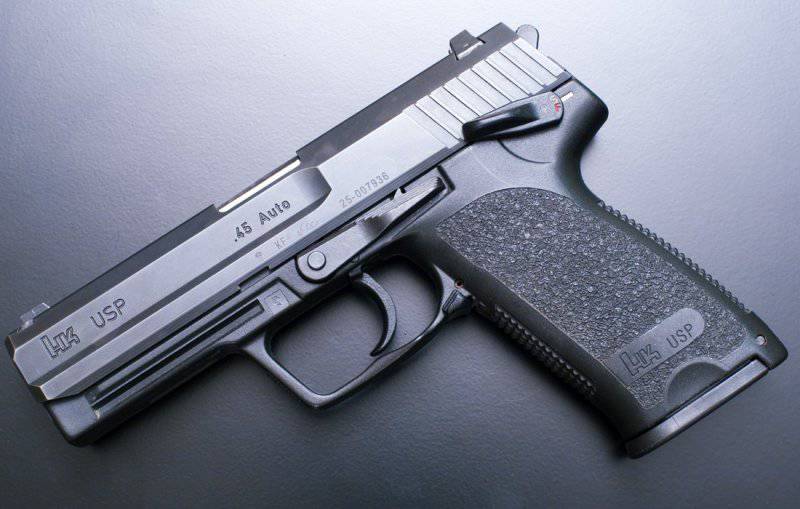
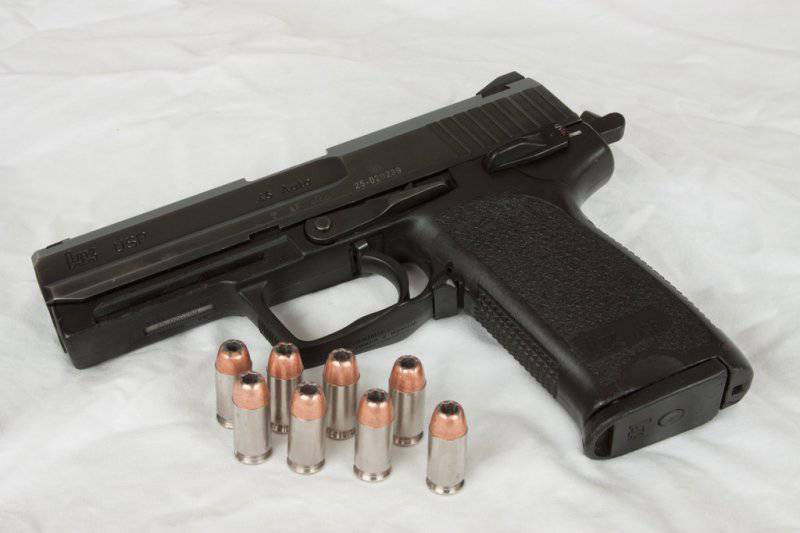
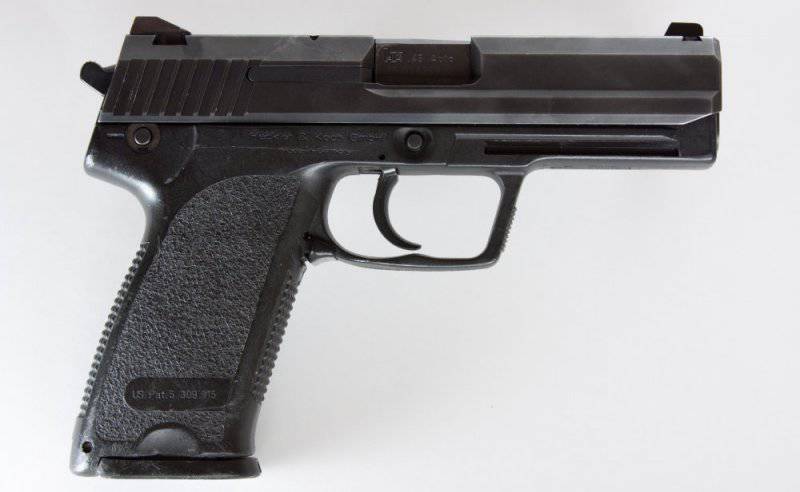
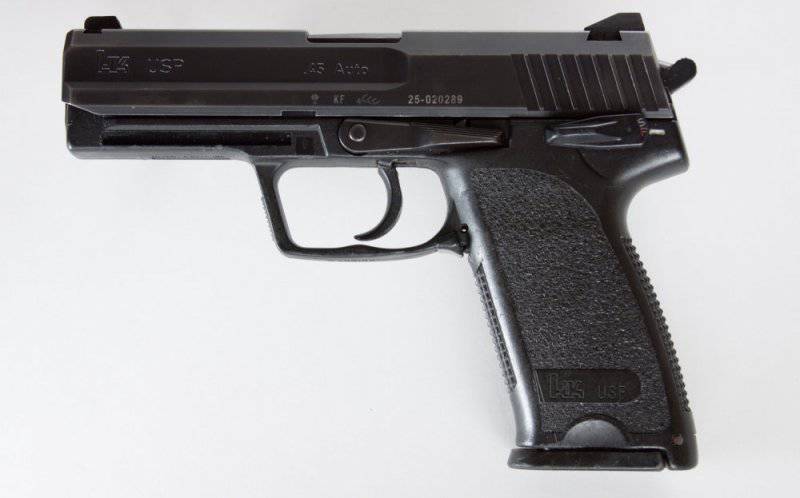
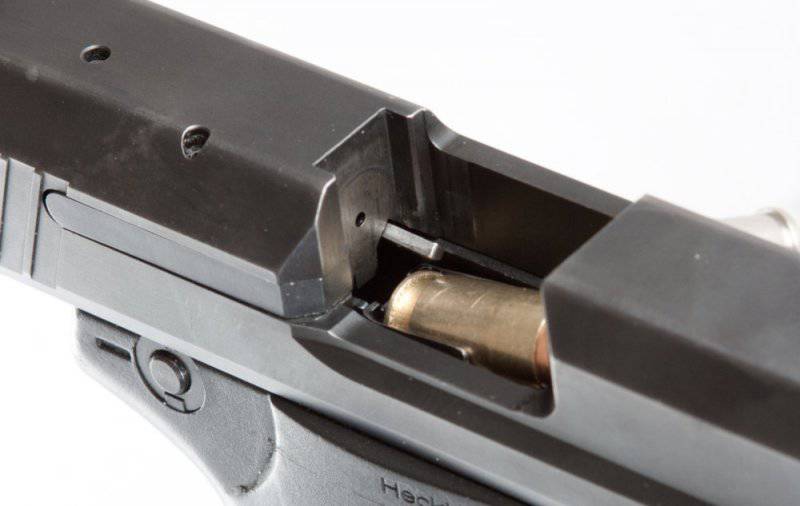

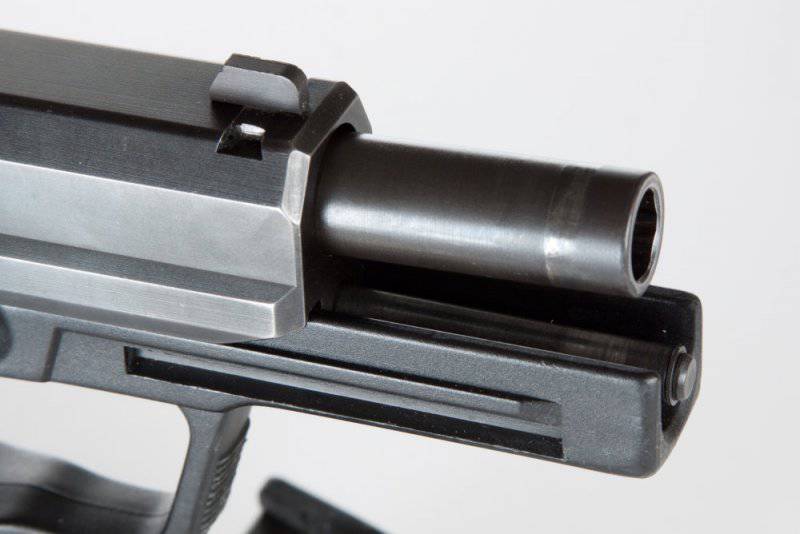

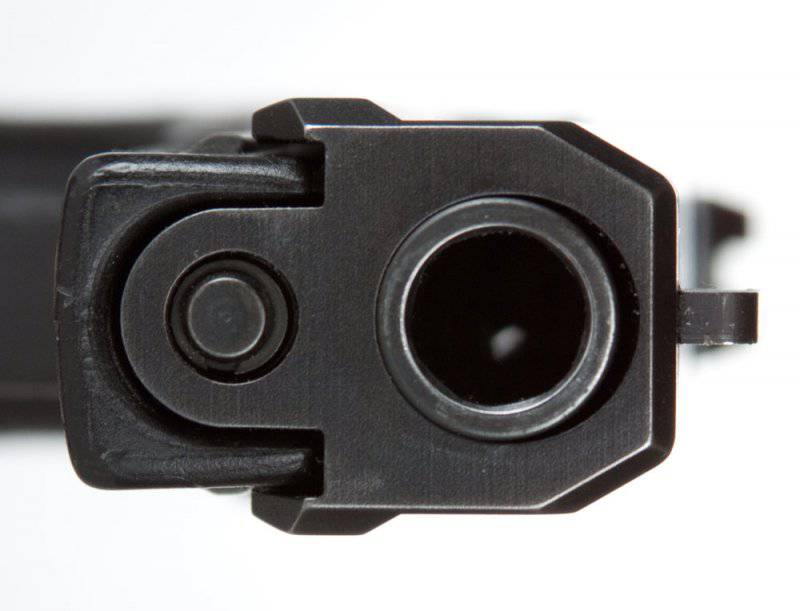
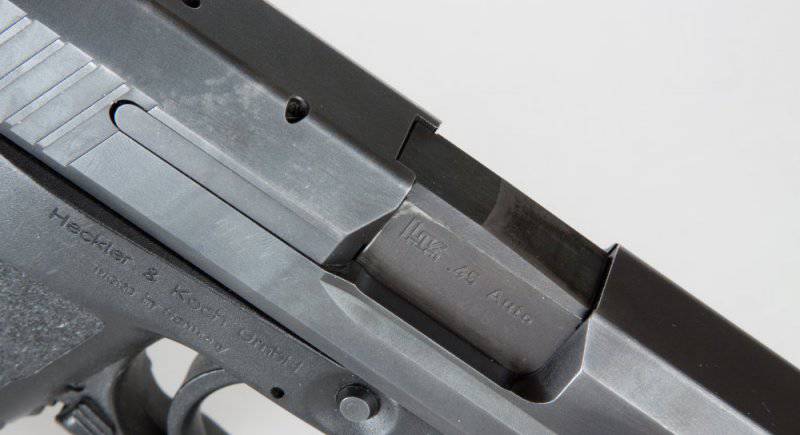
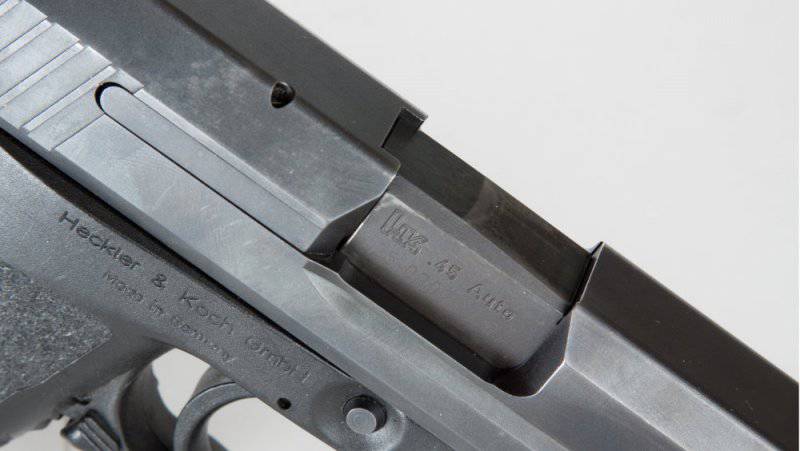


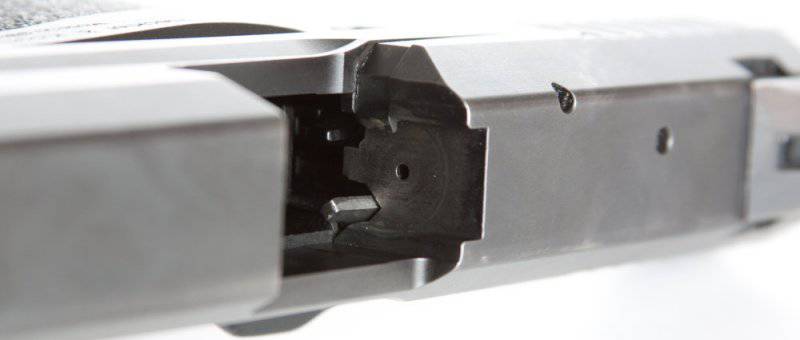

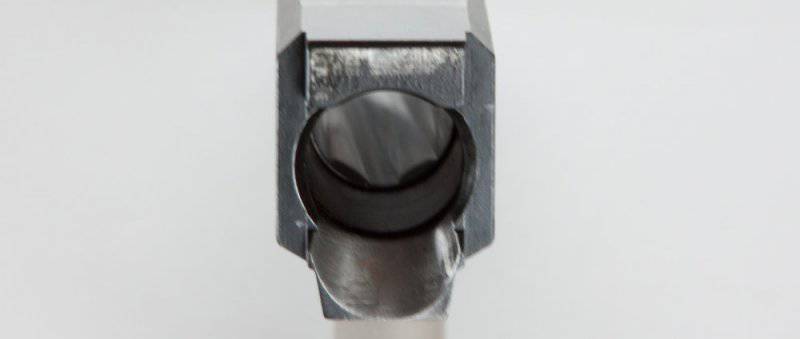

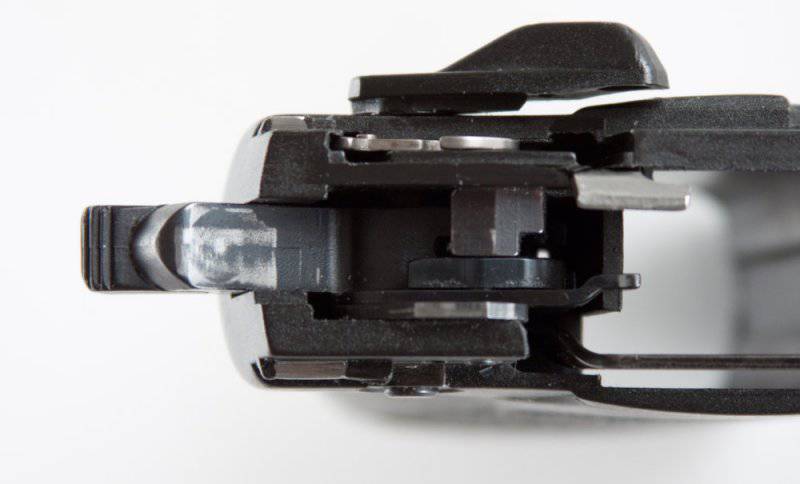
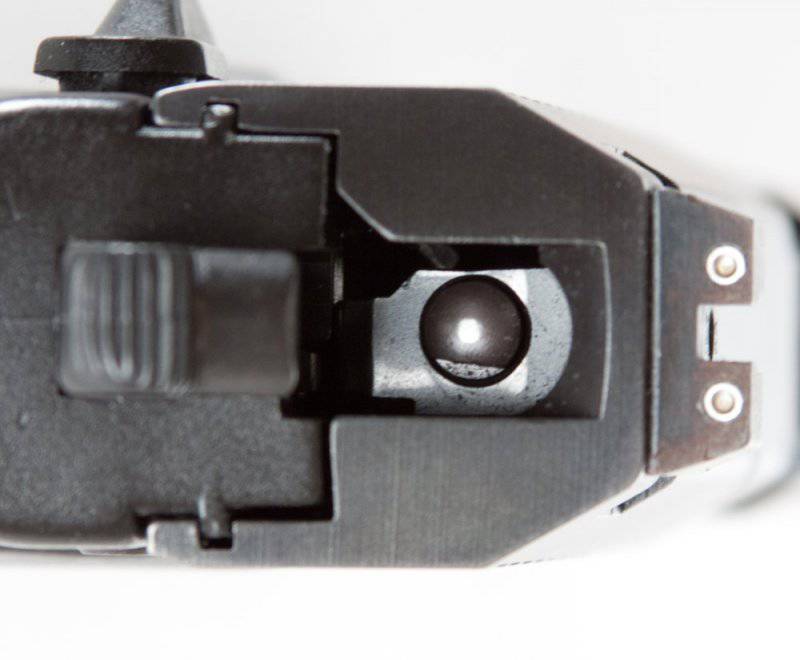
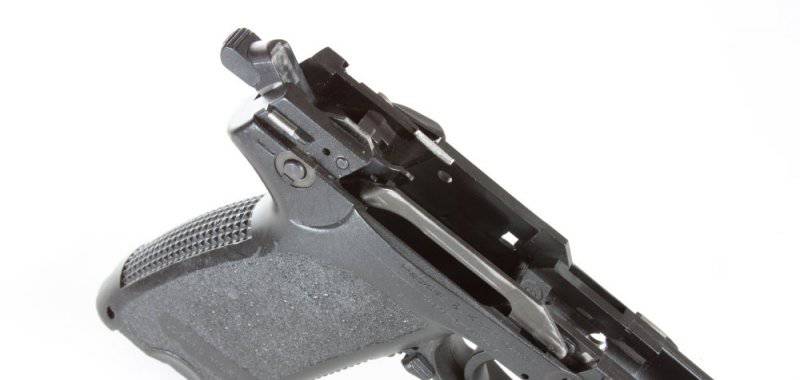
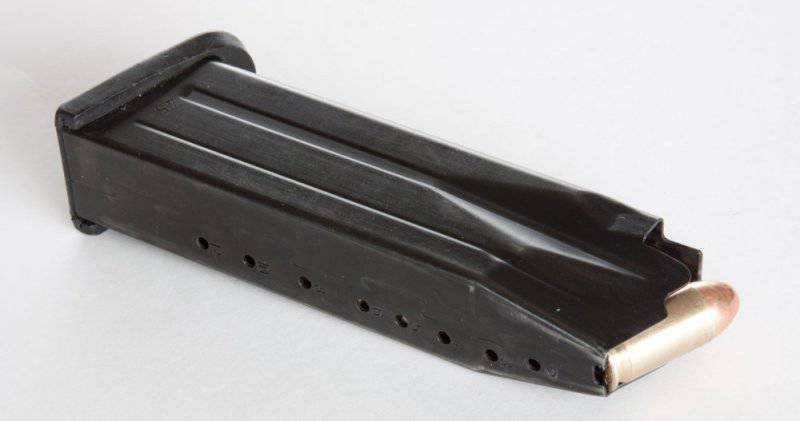
Information